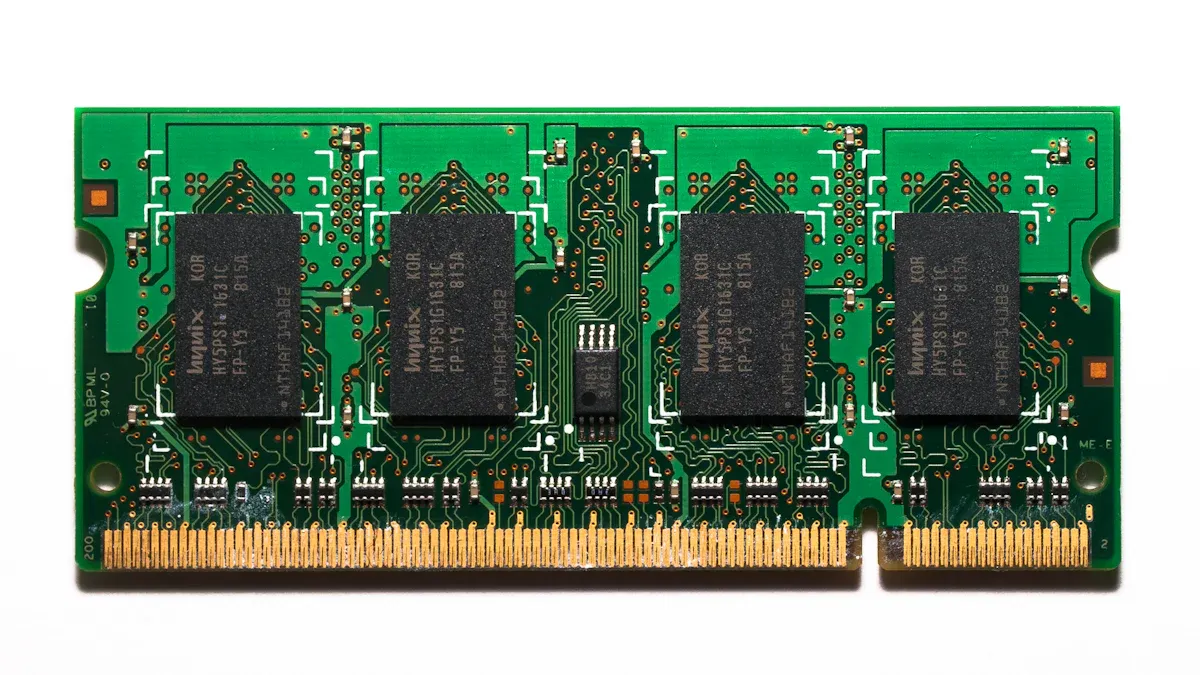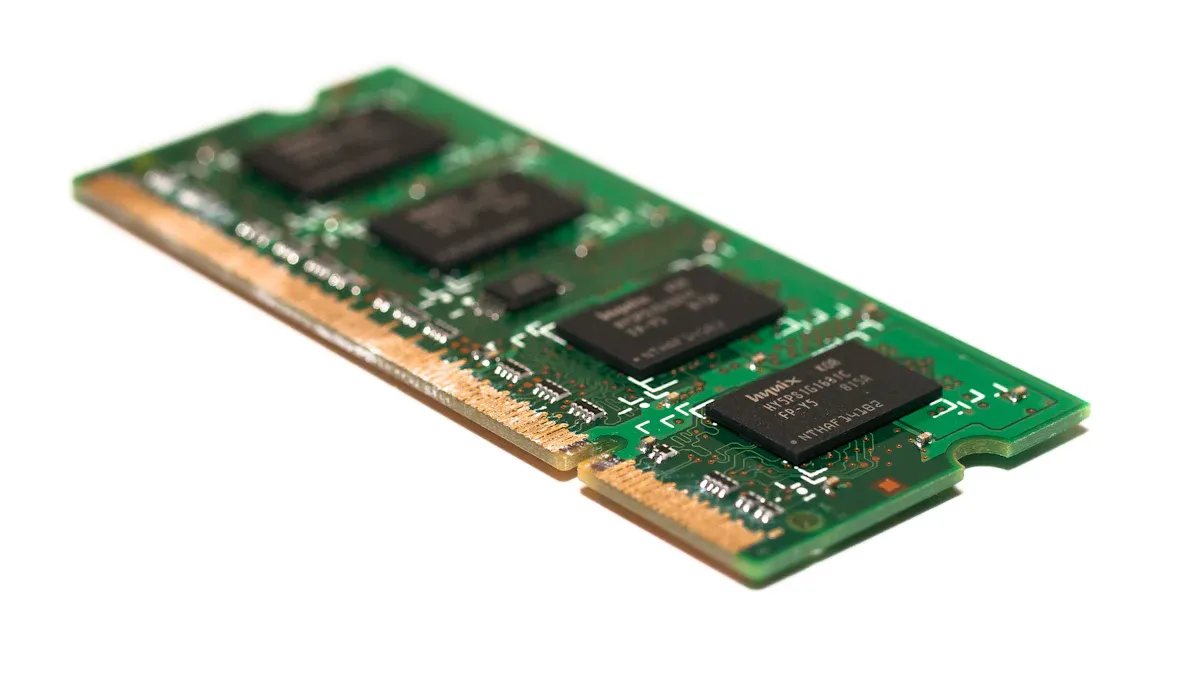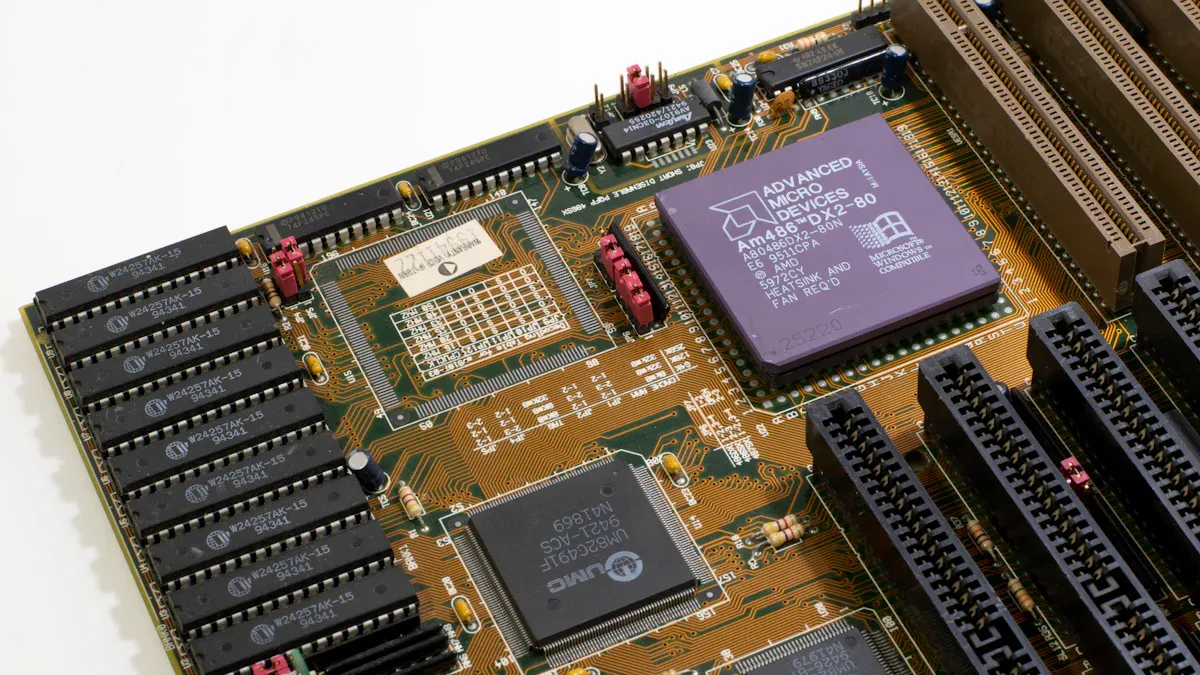What is Static RAM Memory Chip and How It Works

Static RAM Memory Chip is a type of volatile memory that stores data using flip-flop circuits. These circuits consist of transistors that maintain their state as long as power flows through them. Unlike dynamic RAM (DRAM), which requires constant refreshing to retain data, SRAM preserves information without needing periodic updates.
SRAM stands out for its fast data access and lower latency, making it ideal for applications requiring high-speed memory. Its performance advantages have fueled demand in sectors like automotive and telecommunications, especially with the rise of advanced driver-assistance systems and 5G networking technology.
Key Takeaways
Static RAM (SRAM) uses special circuits to keep data safe. It works as long as it has power.
SRAM is faster and quicker than Dynamic RAM (DRAM). This makes it great for fast tasks like CPU memory.
SRAM does not need to refresh like DRAM. This keeps data safe and speeds up getting information.
SRAM costs more to make because it is harder to design. But it saves energy when not in use, so it works well in small devices.
SRAM is used in cars, phones, and internet devices. These need fast data to work well.
How Static RAM Memory Chip Works

SRAM Architecture and Components
The architecture of a Static RAM Memory Chip is designed for speed and reliability. At its core, SRAM consists of an array of memory cells, each built using flip-flop circuits. These cells are organized in rows and columns, allowing you to access specific data by selecting the corresponding row and column.
Each memory cell in SRAM uses six transistors to store a single bit of data. Four transistors form the flip-flop circuit, which holds the data, while the other two act as access transistors. These access transistors connect the memory cell to the bit lines, enabling read and write operations.
SRAM comes in different types, each tailored for specific applications:
Binary SRAM: Offers simple and reliable data access, ideal for high-speed operations.
Quad Data Rate (QDR) SRAM: Doubles data transfer rates by accessing data on both edges of the clock cycle.
Asynchronous SRAM: Operates independently of the system clock, providing flexibility in timing.
Synchronous SRAM: Aligns with the system clock for precise timing, making it suitable for high-performance environments.
This architecture eliminates the need for refresh cycles, which enhances data integrity and reduces latency. Access times are typically just a few nanoseconds, making SRAM significantly faster than other types of memory like DRAM.
The Role of Flip-Flops in Data Storage
Flip-flops are the building blocks of SRAM memory cells. These circuits use pairs of cross-coupled inverters to store a single bit of data. When you write data to an SRAM cell, the flip-flop switches to represent either a "0" or a "1." This state remains stable as long as power is supplied.
The reliability of flip-flops ensures that data can be read without disturbing the stored state. For example, during a read operation, the access transistors connect the memory cell to the bit lines, allowing the stored data to be retrieved while the flip-flop maintains its state. This stability is critical for applications requiring high-speed and error-free data access.
Evidence Type | Description |
|---|---|
Voltage Transfer Characteristics | Cross-coupled inverters in SRAM cells show consistent switching thresholds. |
Read Operation | Data retrieval occurs without altering the stored state, ensuring reliability. |
Stability and Reliability | Flip-flop circuits effectively maintain and switch states for data storage. |
This robust design makes flip-flops a key component in the efficiency and reliability of Static RAM Memory Chips.
Power Supply and Data Retention
SRAM relies on a continuous power supply to retain data. Unlike DRAM, which requires periodic refreshing, SRAM maintains its stored information as long as power is available. This feature eliminates the need for refresh cycles, reducing latency and improving performance.
During idle states, SRAM consumes very little power, making it energy-efficient for applications like CPU cache memory and networking devices. However, frequent read and write operations can increase power consumption. The efficiency of SRAM depends on its design and the frequency of access.
In high-performance applications, such as embedded systems and communication devices, SRAM's ability to retain data without refresh cycles is a significant advantage. It ensures quick data access and reliable performance, even under demanding conditions.
Static RAM vs Dynamic RAM

Differences in Design and Structure
When comparing Static RAM (SRAM) and Dynamic RAM (DRAM), their design and structure reveal key differences. SRAM uses flip-flop circuits made of six transistors to store each bit of data. These circuits maintain their state as long as power is supplied. DRAM, on the other hand, uses a single transistor and a capacitor for each bit. The capacitor stores the charge, but it leaks over time, requiring constant refreshing to retain data.
The structural differences impact their performance and capacity. SRAM's complex design allows faster data access but limits its storage density. DRAM's simpler structure enables higher storage capacity, making it suitable for applications requiring large amounts of memory.
Feature | Static RAM (SRAM) | Dynamic RAM (DRAM) |
|---|---|---|
Speed | 60 nanoseconds | |
Capacity Ratio | 6:1 | 1:1 |
Power Consumption | Lower steady power | Higher burst power |
These differences make SRAM ideal for tasks requiring speed and reliability, while DRAM excels in applications needing high storage capacity.
Speed and Performance Comparison
You’ll notice a significant difference in speed when comparing SRAM and DRAM. SRAM provides faster data access, with speeds as low as 10 nanoseconds. DRAM, in contrast, has slower access times, typically around 60 nanoseconds. This speed advantage makes SRAM the preferred choice for applications like CPU cache memory, where quick data retrieval is essential.
The performance gap also stems from how each type of memory operates. SRAM doesn’t require refreshing, allowing uninterrupted data access. DRAM’s need for constant refreshing introduces delays, reducing its overall efficiency. If you’re working on high-performance systems, SRAM’s speed ensures smoother operations and lower latency.
However, DRAM compensates for its slower speed with higher storage capacity. It’s commonly used in main memory for computers, where large amounts of data need to be stored and accessed sequentially.
Cost and Power Consumption
Cost and power consumption are two critical factors to consider when choosing between SRAM and DRAM. SRAM is more expensive due to its complex design and higher transistor count. DRAM, with its simpler structure, costs less and is widely used in budget-friendly applications.
Power consumption also varies between the two. SRAM uses less power during steady states, making it energy-efficient for devices like networking equipment and embedded systems. DRAM consumes more power, especially during refresh cycles, which can lead to higher energy usage in systems requiring constant memory access.
Type of RAM | Cost | Power Usage |
|---|---|---|
SRAM | More expensive | Uses less power |
DRAM | Less expensive | Uses more power |
If you prioritize energy efficiency and speed, SRAM is the better choice. For applications requiring large memory at a lower cost, DRAM offers a practical solution.
Advantages and Disadvantages of Static RAM
Key Advantages of SRAM
Static RAM Memory Chip offers several benefits that make it a preferred choice for high-speed applications. Its ability to store data without needing refresh cycles ensures faster access and reliable performance. You can retrieve data almost instantly, which is crucial for tasks requiring quick memory operations.
SRAM also excels in random data access. Unlike other memory types, it allows you to access any memory location directly without waiting for sequential operations. This feature enhances efficiency, especially in systems like CPU cache memory.
Another advantage is its medium power consumption. While it uses more power than DRAM during active states, it consumes less energy overall because it doesn’t require constant refreshing. This makes it suitable for devices where energy efficiency is important.
Here’s a summary of SRAM’s advantages:
Characteristic | Description |
|---|---|
Speed | Faster access and operations like read & write. |
Access Efficiency | Data can be accessed randomly. |
Refresh Requirement | Does not need to be refreshed as it stores data statically. |
Power Consumption | Medium power consumption, less than DRAM. |
Usage | Commonly used as cache memory. |
These features make SRAM a reliable and efficient choice for applications requiring speed and stability.
Limitations and Disadvantages of SRAM
Despite its advantages, SRAM has some limitations you should consider. Its complex design requires six transistors per memory cell, which increases manufacturing costs. This makes it more expensive than other memory types like DRAM. If you’re working on a project with budget constraints, this cost factor might be a challenge.
SRAM also has lower storage density. The space required for each memory cell limits the amount of data it can store. For applications needing large memory capacities, DRAM is often a better choice.
Another drawback is its higher power consumption during active states. While it doesn’t need refreshing, frequent read and write operations can increase energy usage. This can be a concern for devices that operate continuously or rely on battery power.
Applications of Static RAM Memory Chip
Use in CPU Cache Memory
Static RAM Memory Chip plays a vital role in CPU cache memory. You’ll find it in processors where speed is critical for performance. CPUs use cache memory to store frequently accessed data, allowing faster retrieval compared to accessing main memory. SRAM’s low latency and high-speed data access make it ideal for this purpose.
Cache memory operates in levels, such as L1, L2, and L3, with L1 being the fastest and closest to the processor. SRAM is commonly used in these levels due to its ability to provide quick access to instructions and data. This ensures smooth operation for tasks like gaming, video editing, and running complex software.
SRAM’s efficiency also reduces the processor’s workload. By storing data closer to the CPU, it minimizes the time spent fetching information from slower memory types. This improves overall system performance and responsiveness.
Role in Embedded Systems
Embedded systems rely on Static RAM Memory Chips for their functionality. These systems are designed for specific tasks, such as controlling appliances, medical devices, or automotive systems. SRAM’s speed and reliability make it a preferred choice for these applications.
You’ll notice that embedded systems often operate in real-time environments. SRAM ensures quick data access, which is crucial for maintaining system responsiveness. For example, in automotive systems, SRAM supports advanced driver-assistance features by processing sensor data rapidly.
SRAM also contributes to power efficiency in embedded systems. Its reduced leakage current and steady-state power consumption make it suitable for devices that run on limited energy sources, such as batteries. This combination of speed and efficiency enhances the performance of embedded systems across various industries.
Applications in Networking and Communication Devices
Networking and communication devices depend heavily on Static RAM Memory Chips. The growing demand for high-speed internet and the rollout of 5G networks have increased the need for SRAM in these devices. You’ll find SRAM in routers, switches, and other equipment where fast data transfer and processing are essential.
SRAM provides low latency and quick access times, which are critical for efficient communication systems. It ensures smooth operation during high-speed data transfers, reducing delays and improving reliability. This makes it a key component in modern telecommunications infrastructure.
The efficiency of SRAM also supports the development of VLSI chips used in networking devices. Its reduced leakage current enhances performance, ensuring stable operation even under heavy workloads. As the telecommunications industry continues to grow, SRAM remains a cornerstone for advancing networking technology.
Static RAM Memory Chip serves as a fast and reliable type of volatile memory. It stores data using flip-flop circuits and retains information as long as power is supplied. You benefit from its speed, low latency, and energy efficiency, especially in applications like CPU cache memory and embedded systems. However, its higher cost and lower storage density limit its use in large-scale memory solutions.
SRAM plays a crucial role in modern technology. Its ability to deliver quick data access supports advancements in telecommunications, automotive systems, and high-performance computing. By understanding its strengths and limitations, you can appreciate why SRAM remains essential in today’s digital world.
FAQ
What is the main difference between SRAM and DRAM?
SRAM uses flip-flop circuits to store data, while DRAM relies on capacitors and transistors. SRAM doesn’t need refreshing, making it faster. DRAM requires periodic refreshing, which slows it down but allows higher storage capacity.
Why is SRAM more expensive than DRAM?
SRAM’s design uses six transistors per memory cell, increasing manufacturing complexity and cost. DRAM uses fewer components, making it cheaper to produce. You’ll find SRAM in high-speed applications, while DRAM suits large-scale memory needs.
Can SRAM be used as main memory in computers?
SRAM isn’t practical for main memory due to its high cost and lower storage density. It works best as cache memory for CPUs, where speed matters most. DRAM is the preferred choice for main memory because of its affordability and capacity.
How does SRAM retain data without refreshing?
SRAM stores data in flip-flop circuits that maintain their state as long as power is supplied. This eliminates the need for refresh cycles, ensuring faster access and reliable performance. You’ll benefit from its efficiency in applications requiring quick data retrieval.
Is SRAM energy-efficient?
SRAM consumes less power during idle states but uses more energy during frequent read and write operations. Its steady-state efficiency makes it suitable for devices like embedded systems and networking equipment. You’ll find it ideal for applications balancing speed and power usage.
See Also
Understanding Communication Chips: Functionality and Applications
Key Innovations Shaping Memory Chip Production by 2025
Exploring Temperature Sensor Chips: Features and Functions
